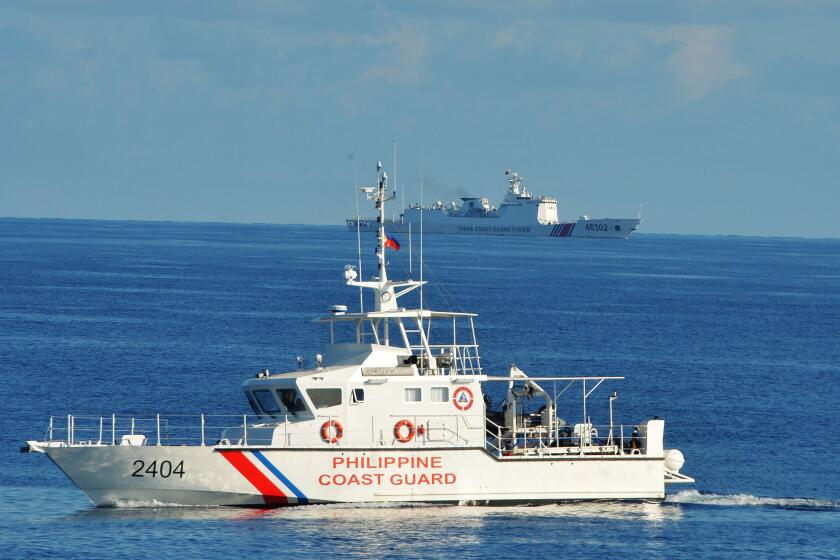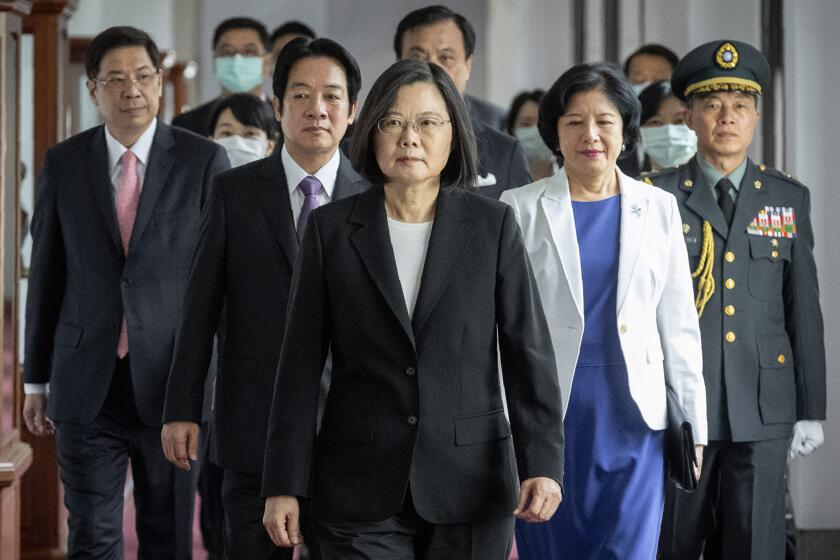The U.S. wants Asian allies to stand up to China. It’s not that easy
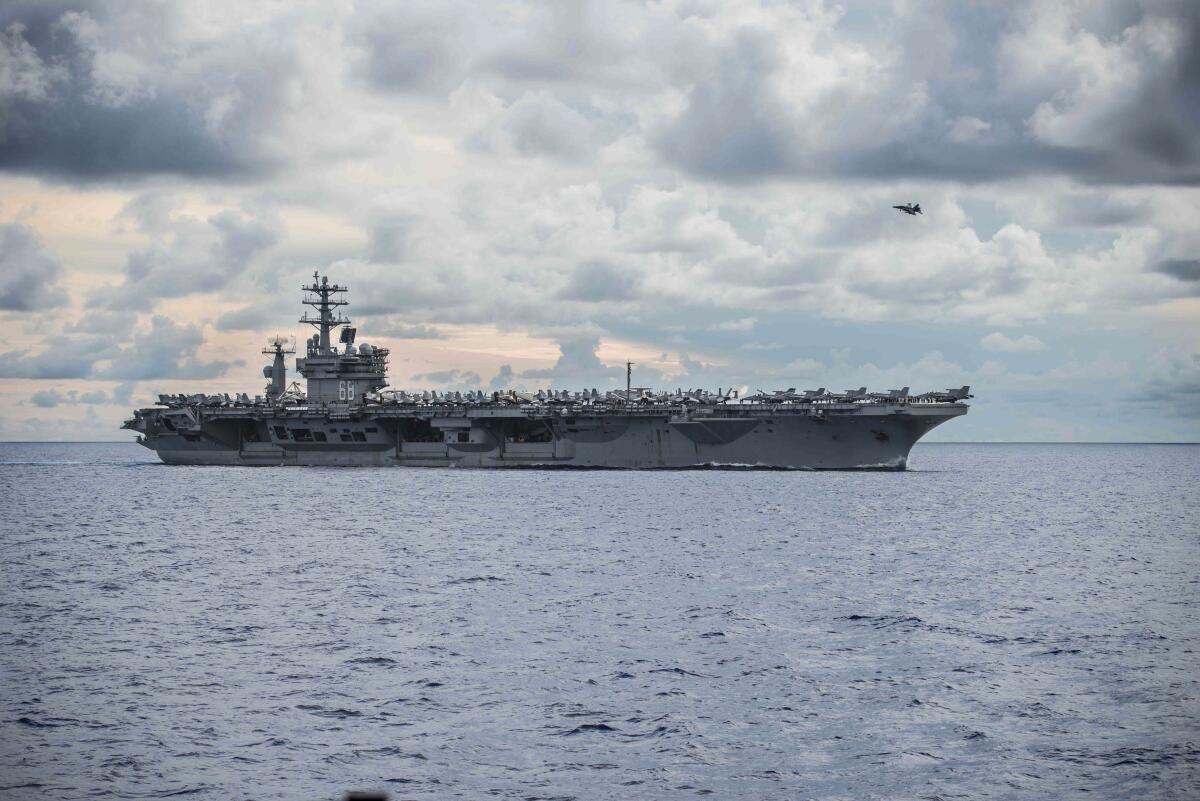
- Share via
SINGAPORE — Seeking support in a budding cold war with Beijing, the U.S. is looking to Southeast Asia, where longstanding allies and security partners have clashed with their giant neighbor in the resource-rich South China Sea.
China’s claims over nearly the entire waterway — impeding fishing and oil exploration, sinking smaller countries’ vessels and inciting military confrontations — were ruled illegal by an international tribunal in 2016. The State Department formally endorsed that ruling this week, denouncing China’s “completely unlawful” claims and “bullying” of rivals.
The bristling, 750-word statement marked a significant policy shift by the U.S., spelling out for the first time that it regarded China’s sailing of warships through other nations’ waters and construction of military facilities on disputed rocks and reefs — which it had long described as provocative and dangerous — as illegal.
But the tougher U.S. stance illustrates a central challenge facing Washington as it tries to build pressure against China: While weaker Asian countries might recoil at China’s aggressive behavior, none wants to be dragged into an open confrontation between two increasingly acrimonious powers.
“Not all Southeast Asian states will think the U.S. statement is a good thing,” said Ngeow Chow Bing, director of the Institute of China Studies at the University of Malaya, in Malaysia. “They are quite worried that this will only mean an intensification of the U.S.-China rivalry, which could further destabilize the region.”
As U.S.-China frictions worsen, Asian leaders, who watched tensions rise this month when Washington sent two aircraft carriers into the South China Sea, have voiced a common sentiment: They don’t want to be forced to choose sides.
On the site of a former World War II garrison where the U.S.
Many Southeast Asian countries have historically close diplomatic and economic ties with the U.S. and oppose what Secretary of State Michael R. Pompeo called Beijing’s attempts “to treat the South China Sea as its maritime empire.” Over the past year, Chinese oil exploration ships have ventured into waters claimed by Vietnam and Malaysia, and Chinese vessels have sunk Vietnamese and Filipino fishing boats.
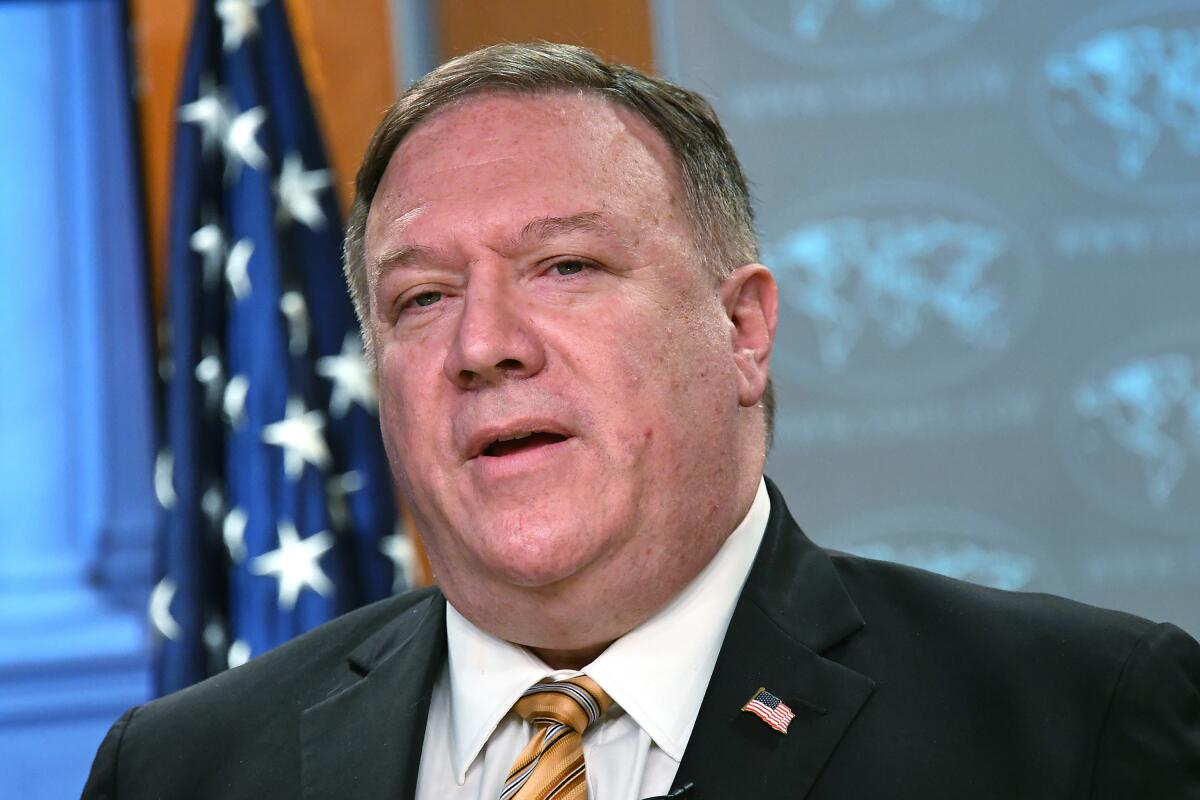
Following the Philippines, which took China to the tribunal in 2016 and won, Malaysia and Indonesia have recently lodged challenges at the U.N. to China’s so-called nine-dash line — a broken line on Chinese maps that delineates what it sees as its maritime space, encircling roughly 90% of the South China Sea.
U.S. officials hope the statement could “[lay] the groundwork for a long-term effort to rally international opposition to China’s claims, support the Southeast Asian parties and bring diplomatic and economic pressure to bear in the hopes of moving Beijing toward compromise,” said Gregory B. Poling, director of the Asia Maritime Transparency Initiative at the Center for Strategic and International Studies.
But many of the rival claimants are also heavily reliant on China for trade and investment and wary of angering the dominant power in the neighborhood. Their silence on the U.S. statement suggests they don’t want to get ensnared in U.S.-China tensions, said Collin Koh, a research fellow at the S. Rajaratnam School of International Studies in Singapore.
“For some of them at least, making an official statement in support of Pompeo’s statement could potentially put them in a spot, considering their economic dependence on China,” Koh said.
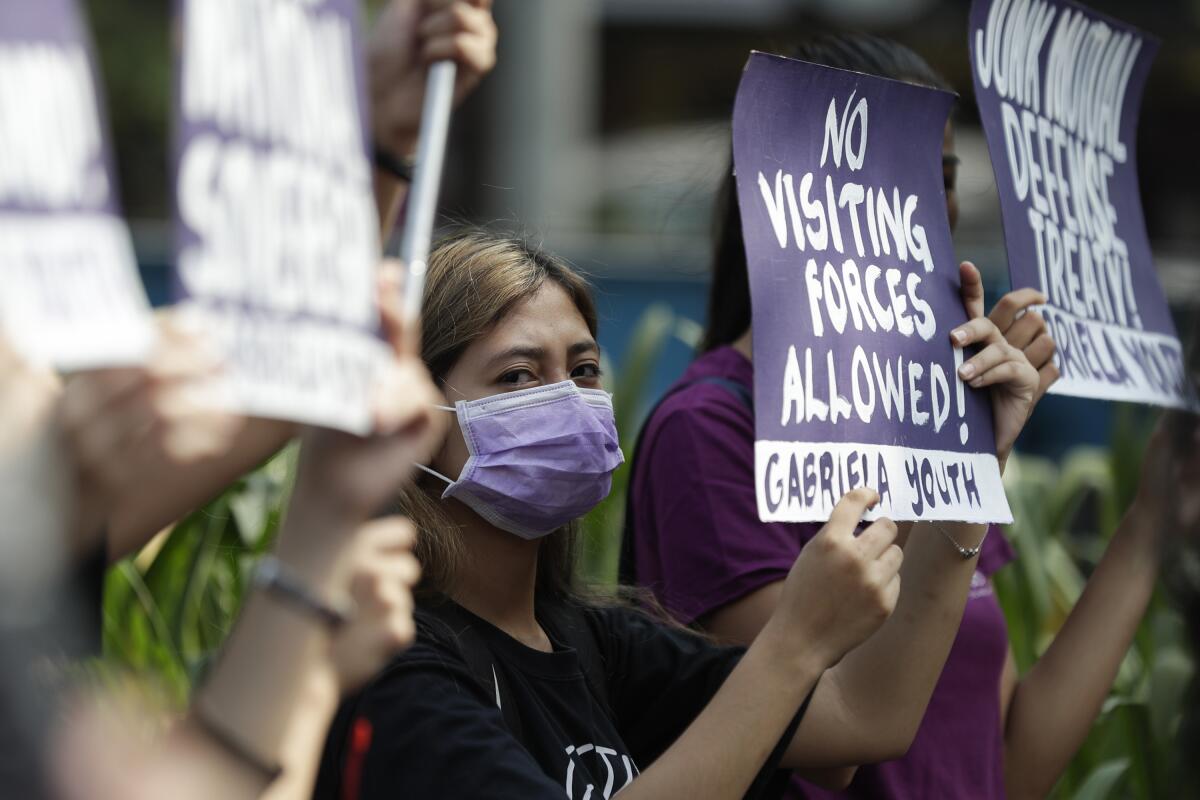
Those worries have deepened as the COVID-19 pandemic batters regional economies and as an increasingly nationalistic China has moved to consolidate its territorial claims, clashing with Indian forces on their disputed boundary in the Himalayas and imposing a harsh new security law on Hong Kong. President Trump on Tuesday signed an executive order he said would punish China for “oppressive actions” in Hong Kong, ending the territory’s U.S. trade privileges and revoking special treatment for its passport holders.
As Trump steadily hardens his stance against Beijing, the South China Sea, the conduit for $4 trillion in annual maritime trade, is often described as the likeliest place for a U.S.-China military clash. China on Tuesday accused the U.S. of “stirring up tension and inciting confrontation,” further damaging a relationship that the Chinese foreign minister recently said had hit its lowest point since diplomatic ties were established four decades ago.
“I think Beijing will view this U.S. move as the latest evidence that the Trump administration is hellbent on competing with and countering China … at every turn both regionally and globally,” said Derek Grossman, a senior defense analyst at the Rand Corp.
China’s aggressive military activity in the disputed waterway has continued even as it seeks a global leadership role fighting the pandemic.
But rival claimants “were likely to receive this U.S. policy shift in differing ways,” Grossman added.
Malaysia, for example, has consistently played down confrontations between its offshore oil exploration vessels and Chinese government and coast guard ships in contested waters.
It made few public statements this year during a months-long standoff involving a Chinese government survey vessel and a Malaysian drill ship, the West Capella, even after the U.S. sailed warships into the area as a message to China.
While Malaysia has formally challenged China’s nine-dash line at the U.N., it has preferred to resolve dustups at sea quietly.
“Malaysia is quite worried that the purpose of this U.S. statement is not just to assure the rights of claimants but also to encourage South China Sea countries to form a united front against China,” Ngeow said. “A grand coalition against China — that is not the sort of policy that Malaysia wants to pursue.”
A pandemic, an economic downturn and an untested military have forced Beijing to temper calls for war. The move highlights the dangers of harnessing nationalism to bolster party control.
In the Philippines, populist President Rodrigo Duterte has cozied up to China and declined to enforce the 2016 ruling, to the consternation of his military establishment. Duterte’s spokesman, Harry Roque, said Tuesday that the maritime dispute “does not sum up our relations with China.”
“We will proceed with our friendly relations,” he said. “The matters that can move forward will move forward. The issues that cannot be resolved will be set aside.”
More stories from Asia
U.S. officials were deeply worried earlier this year when Duterte said he would scrap the Visiting Forces Agreement, a decades-old pact that allows American military personnel to operate in the Philippines and is a linchpin of the U.S. security strategy in the Asia-Pacific.
But last month Duterte abruptly suspended that decision, leading to speculation that volatility in the South China Sea had caused him to rethink the wisdom of disrupting a treaty alliance that requires the U.S. to defend the Philippines if attacked.
Analysts said it wasn’t immediately clear whether the U.S. statement would translate to more military patrols in the region. The Pentagon has already sailed warships through the South China Sea six times this year, including the deployment of two aircraft carriers simultaneously this month in a move that Beijing called “provocative.”
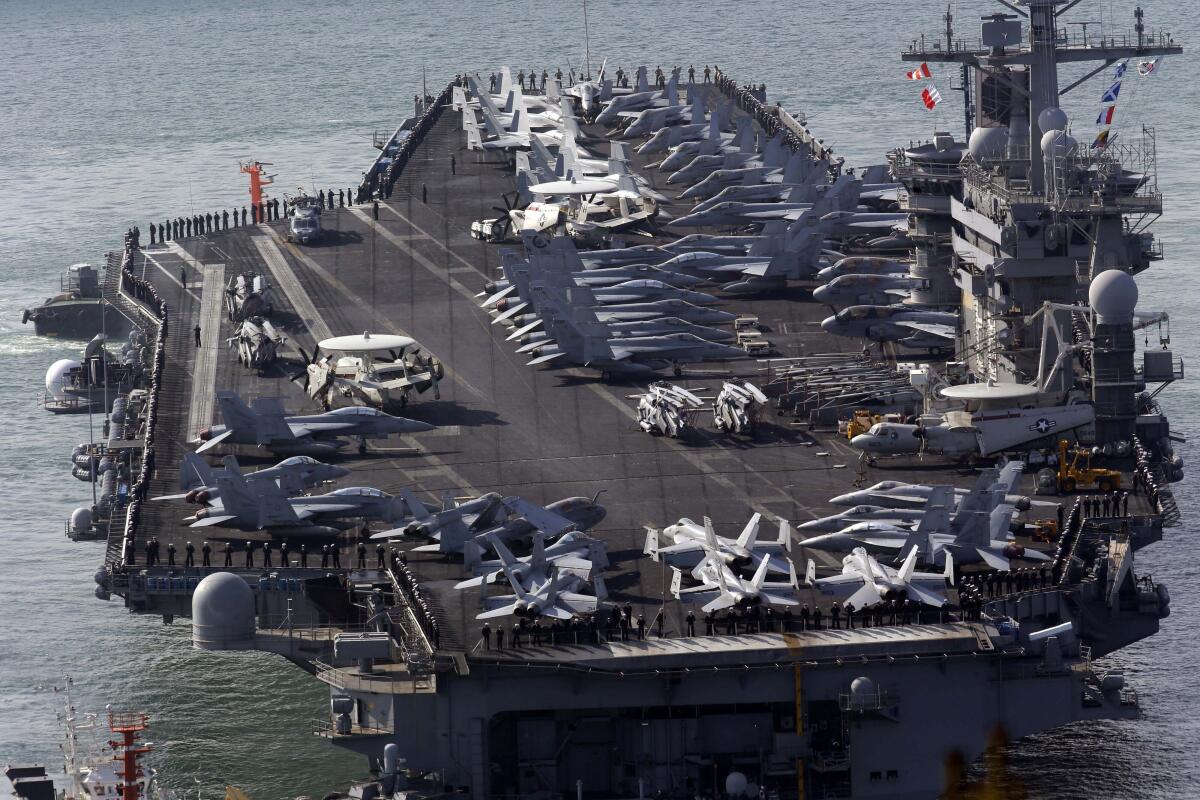
The so-called freedom of navigation patrols have done little to protect Southeast Asian nations’ territorial claims. But some experts said the U.S. statement would make the operations more welcome, even as countries worry about the risk of escalation.
“These will be seen as necessary risks,” said Jay Batongbacal, a maritime affairs expert at the University of the Philippines College of Law. “The smaller states know that without a more robust U.S. presence, China will be throwing its weight around even more than what they have witnessed in the past two years.”
More to Read
Sign up for Essential California
The most important California stories and recommendations in your inbox every morning.
You may occasionally receive promotional content from the Los Angeles Times.

